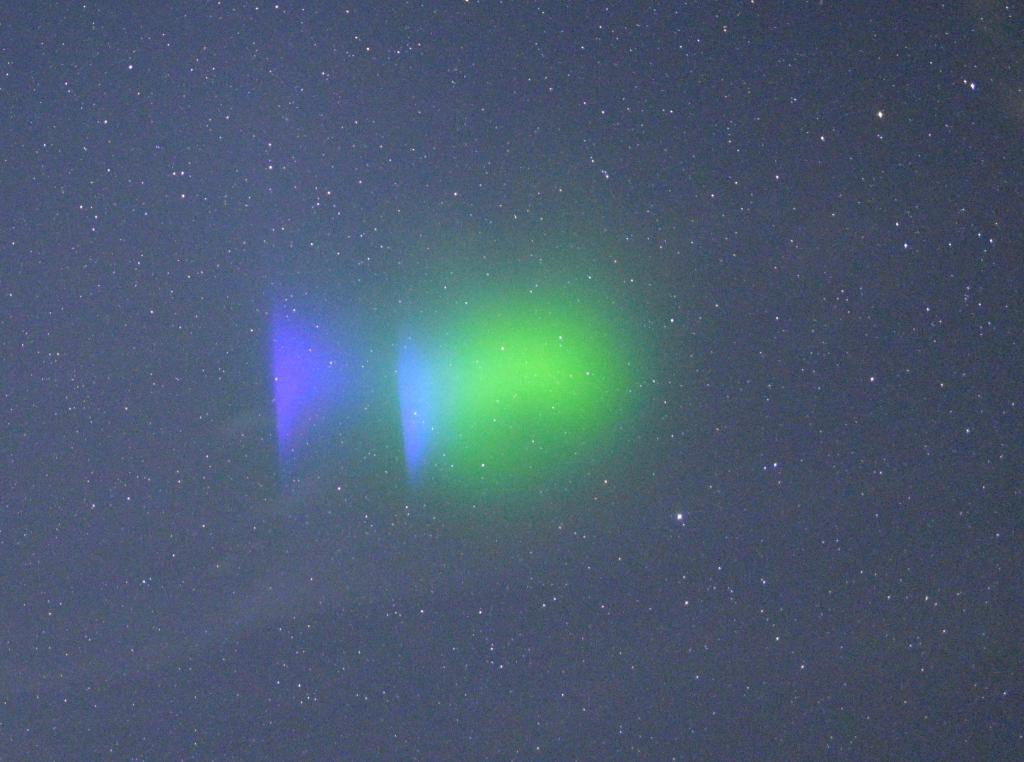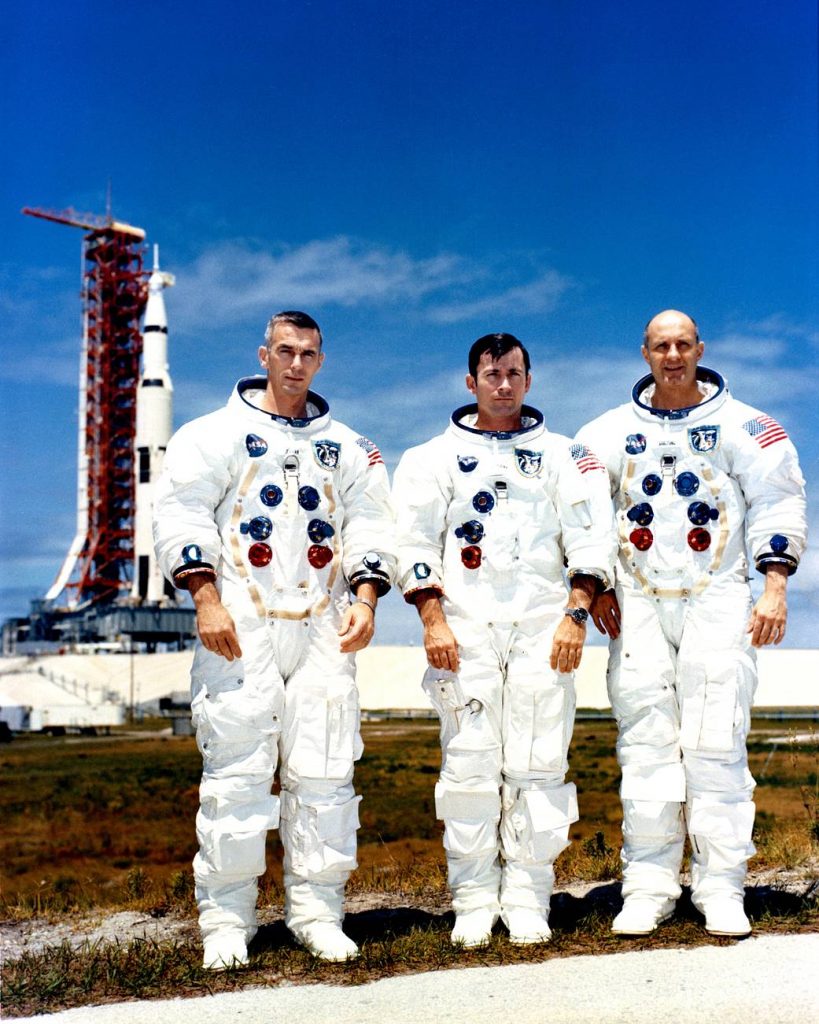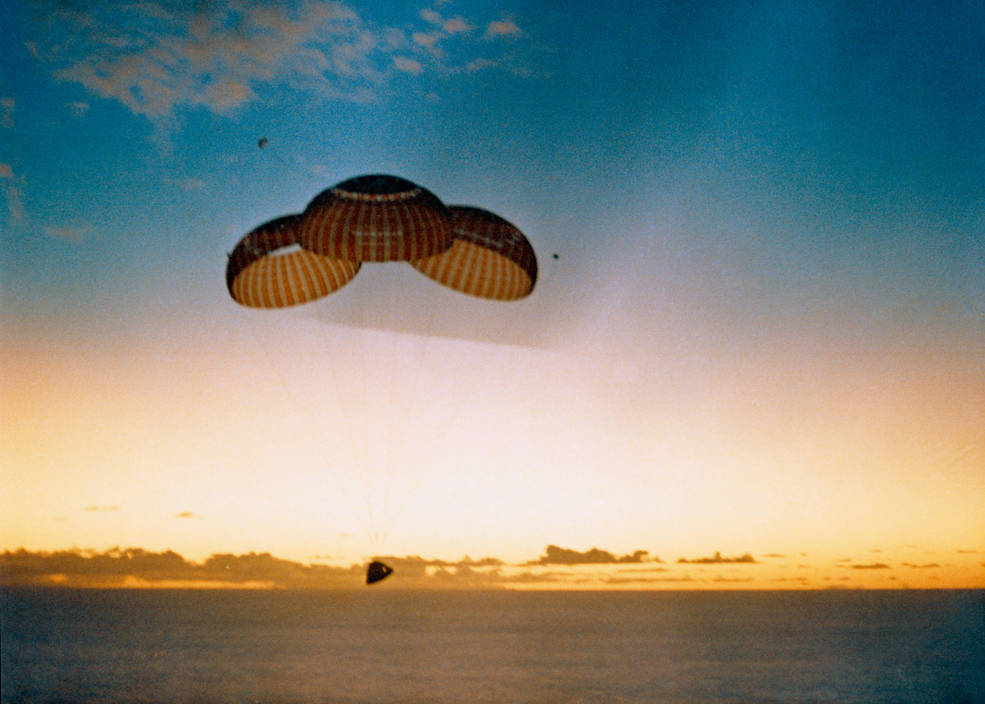This week, we share a Rocket Lab launch failure (but first stage recovery success), yet another Starlink (with rideshare payloads), and a rare-sounding rocket launch. Plus, this week in rocket history, we take a look back at a key early mission: Apollo 10, which launched on May 18th, 1969.
Media
Transcript
Hello, and welcome to the Daily Space. My name is Annie Wilson and most weekdays the CosmoQuest team is here putting science in your brain.
Today, however, is for Rocket Roundup. Let’s get to it, shall we?
We don’t usually cover suborbital launches here on Rocket Roundup, but we do make an exception if the mission is notable, and the KiNET-X launch is one such notable mission. On May 16 at 00:44 UTC, NASA launched a Black Brant 12 sounding rocket from the Wallops Flight Facility in Virginia. The launch had been delayed several times and the sixteenth was the last date the mission could launch during this launch window.

Most of the delays were due to weather at a ground observation site in Bermuda, but one was because the rocket was damaged by a collision with part of the structure on the launch pad on May 12.
So why launch a sounding rocket instead of a regular rocket? Some small experiments only need to experience microgravity or no atmosphere for a very brief period of time — usually just a few minutes. A sounding rocket can provide those brief trips to space for a fraction of the cost of launching a larger rocket.
Before I talk about the science on board, let’s go over the rocket specs. This particular sounding rocket, the Canadian Black Brant 12, is a four-stage rocket that is essentially four smaller rockets stacked atop each other: a Talos first stage, a Terrier second stage, a Black Brant third stage, and a fourth stage which was purpose-built as a sounding rocket stage. (The rocket motors from the other three stages were derived from missiles.)
Onboard the four-stage rocket was KiNET-X, short for the KiNETic-scale energy and momentum transport eXperiment.
KiNET-X is investigating how the Earth’s aurora gets its high-energy particles. According to payload Principal Investigator Peter Delamere, the solar wind is made of low-energy particles, and it is currently unknown how the high-energy particles in the aurora get their energy. Smithsonian physicist Jonathan Mcdowell likens the experiment to an electrocardiogram for space plasma. (If you’re unfamiliar with an electrocardiogram, they are used to measure your heart’s rhythm and electrical activity.)
Because we can’t physically connect an electrocardiogram to space plasma, KiNET-X investigated this connection by deploying two barium vapor canisters to light up the night sky. The glowing is actually pretty important: the barium allows us to see the way high-energy electrons travel through the magnetic field lines. Along with the barium vapor, several other payloads were deployed by the sounding rocket. Instruments on these payloads, as well as instrumentation on the rocket, measured the electric and magnetic fields. In addition to onboard and deployed instruments, the barium vapor was observed from a site in Bermuda.
That ionized barium vapor also provided quite a visual show to viewers in the eastern United States and Canada. Because of peculiarities in the Earth’s magnetic field above Virginia and the surrounding area, the ionized cloud spread out into short trails of visible violet light for about thirty seconds, like purplish streamers. According to NASA, the human eye is not very sensitive to violet when dark-adapted, so the colors showed up better in photographs and appeared as violet and green clouds, almost like a miniature aurora.
Next up, on May 15 at 11:11 UTC, Rocket Lab launched their twentieth Electron rocket from their LC-1A pad on the Mahia Peninsula in New Zealand. It was carrying two Earth observation satellites for Blacksky Global. Spoiler alert: they did not go to space that day.

The launch was delayed about an hour from its originally scheduled time due to high upper-level winds. After the conditions had improved, the team smoothly counted down to zero, and the rocket lifted off the pad in the pitch darkness. All looked good during the ascent up until second stage ignition when the engine appeared to shut down just a few seconds after it started. Immediately after that happened, the engine gimbal went hard over in one direction, sending the rocket spinning.
The feed from the engine camera was lost shortly afterward, but not before it showed the engine bell cooling down. That was not a good sign. An engine bell only cools down when the engine isn’t firing, and the engine should have been firing at this point. Rocket Lab ended the stream early citing the loss of telemetry. Later on Twitter, they confirmed the failure citing a generic “anomaly following second stage ignition”.
This was to be the first of several dedicated missions for Blacksky Global, sending pairs of their 60-kilogram (30 two-liter soda bottles) satellites into orbit to meet the new demand for their imaging services.
Not all was lost! The secondary mission for “Running Out of Toes” was the recovery of the first stage — a baby step towards reusability. The first stage successfully survived reentry through the atmosphere and a parachute-assisted splashdown 663 kilometers downrange where it was retrieved from the water by contracted ship Seaworker.
Also, this week was yet another Starlink launch, but this one was slightly different. On May 15 at 22:54 UTC, Starlink L26 launched from LC-39A at the KSC. Instead of the usual complement of 60 Starlink satellites, Booster 1058 only carried 52 Starlink along with two rideshare payloads as part of its eighth flight. Rideshares are paying customers piggybacking a ride to a similar orbit as the Starlink.

After 98 minutes of coasting and two burns of the second stage, all 54 satellites were successfully deployed into orbit. This brought the number of Starlink satellites launched to 1,677.
The second stage put the payloads into a 566-by-584-kilometer orbit inclined at 53 degrees. This is about twenty kilometers above the operational constellation because the rideshare payloads needed a higher insertion orbit. Instead of raising their orbits, the 52 Starlink will have to lower them to become operational.
One of the rideshare payloads was a 112-kilogram (66 two-liter soda bottle) Capella Space synthetic-aperture radar satellite, while the other was Tyvak 0130, a CubeSat designed to do astronomy in optical wavelengths. Tyvak-0130 is a 6U 11-kilogram spacecraft, about the size and weight of a briefcase. It has a unique telescope system: one piece of glass with reflective coatings on both ends. According to the engineers at Lawrence Livermore National Lab who build the telescope, the “telescope design does not require precise alignment between two separate mirrors to ensure proper focusing, simplifying the design and allowing a smaller, less expensive spacecraft to carry the monolithic telescope.” Tyvak-130 is capable of monochrome or color imaging for Earth observation, astronomy, and space situational awareness.
For those of you keeping score at home, Booster 1058 successfully landed on the droneship Of Course I Still Love You stationed downrange in the Atlantic. Both fairings were on their second flights, one having flown on the SXM-7 mission and the other on NROL-108. Only one fairing was recovered from the water.
This Week in Rocket History
This week in rocket history we’re remembering an important step in America’s lunar landing program: Apollo 10.

Apollo 10’s goal was to do an end-to-end rehearsal of the entire Apollo Command/Service Module and Lunar Module stack in Lunar orbit in preparation for the lunar landing attempt. Commanding the mission was Tom Stafford; John Young was the command module pilot; Eugene Cernan was the lunar module pilot.
Apollo 10 was launched at 16:49 UTC on May 18, 1969, the first and only Saturn 5 launch from LC-39B. Yes, LC-39B. LC-39A, the usual launchpad for the Saturn 5, was being used for the parallel launch campaign of Apollo 11. Two rockets can’t occupy the same space so Apollo 10 had to scootch over a pad.
The launch was nominal. Two and a half hours into the mission the Saturn V third stage lit its engines for just over five and a half minutes (precisely 343 seconds) to perform a Trans Lunar Injection burn, sending the stack towards the Moon.
Twenty minutes after Trans Lunar Injection, the Command Module Charlie Brown separated from the third stage. Command Module Pilot Young performed the transposition maneuver, a fancy word for it turning around and removing the Lunar Module Snoopy from where it was stored on the third stage. The process was broadcast to TV live.
The cruise to the Moon was also nominal with a fifteen meters per second midcourse correction. This maneuver was so accurate that the two other planned corrections were canceled.
Almost 76 hours into the mission, the Command/Service Module engine fired for just under six minutes to insert the stack into Lunar orbit. The crew did a live TV broadcast four hours later showing viewers details on the lunar surface.
Cernan and Stafford entered the Lunar Module 95 hours into the mission to activate systems and prepare for their solo spacecraft demonstration. Three and a half hours later, they undocked. The two crew members in the Lunar Module checked out its systems and extended the legs. After a few minutes, Young in the Command Module performed an 8.3-second burn of the Reaction Control Thrusters on his spacecraft to increase the separation between the two spacecraft. He then flew around Snoopy for a visual inspection.

Once the inspection was complete, Young performed another burn to move the Command/Service Module a kilometer away from the Lunar Module.
One hour after undocking from the Command/Service Module, the Lunar Module lowered its orbit around the Moon. In this lower orbit, the crew passed directly over the planned landing site for Apollo 11 and took many pictures. The two astronauts were so distracted by looking at the lunar surface that they briefly forgot to fly the spacecraft, letting it drift out of yaw alignment slightly. They also tested the landing radar during this orbit. According to their measurements, the closest they ever got to the lunar surface was just under 14.5 kilometers.
You might be wondering why they didn’t land. Quite simply, they couldn’t. The ascent stage on the Lunar Module was deliberately under-fueled. If Cernan and Stafford were to land on the Moon, they wouldn’t have enough fuel to be able to return to the Command/Service Module in orbit. Remember: Apollo 10 was never meant to land on the Moon, just to act as a dress rehearsal for the real thing.
The next step was to rendezvous with the Command Module. All went well for the first three hours. And then Stafford and Cernan realized they had a problem when the spacecraft started rolling erratically. The cause? The abort guidance computer. It was set incorrectly: instead of being in attitude hold mode, it was in auto mode. Essentially the spacecraft was rolling around trying to lock on to the Command Module with its radar when it shouldn’t have. Cernan re-established control manually, with only a brief “we’re in trouble” to relay any sign of concern for the mission.
The Lunar Module performed another burn to simulate the orbit that a Lunar Module would be in after ascent from the lunar surface. After this, the engines were lit for a second burn to raise its orbit back up to the apogee of the Command Module. After a series of other rendezvous burns and phasing, docking was completed three hours and 22 minutes later, and Stafford and Cernan transferred exposed film and other supplies into Charlie Brown. The Lunar Module Ascent stage was jettisoned shortly afterward.
Twenty-eight minutes later, the ascent stage engine of the Lunar Module was remotely commanded to burn to depletion which sent the spacecraft into solar orbit.

At 137 hours and 39 minutes into the flight, the trans-Earth initiation burn was conducted, sending Apollo 10 to an ocean landing. During the trip back, the crew passed the time with six TV transmissions and several celestial navigation exercises.
The astronauts began their reentry into Earth’s atmosphere nearly eight days into the mission. Splashdown and the end of the mission were achieved at 192 hours, three minutes, and 23 seconds. The crew was retrieved by a helicopter from the USS Princeton, arriving onboard 39 minutes after splashdown.
Statistics
To wrap things up, here’s a running tally of a few spaceflight statistics for the current year:
Toilets currently in space: 6: 3 installed on ISS, 1 on the Crew Dragon, 1 on the Soyuz, and 1 on Tianhe
Total 2021 orbital launch attempts: 44, including 2 failures
Total satellites from launches: 1045

I keep track of orbital launches by where they launched from, also known as spaceport. Here’s that breakdown:
USA: 19
China: 13
Kazakhstan: 4
Russia: 3
New Zealand: 3
French Guinea: 1
India: 1
Random Space Fact
Your random space fact for this week is that Virgin Orbit had to stop using one of their rocket engine test stands when a family of House Finches built a nest right on the stand. House Finches are protected under federal law, so Virgin Orbit had to wait a few weeks until the birds hatched and left the nest before they could resume using the engine test stand.
Learn More
KiNET-X Launches on Tiny Four-stage Rocket
- NASA Wallops May Rocket Launch Exploring Energy Transport in Space (NASA)
- Black Brant 12A info page (Gunter’s Space Page)
Rocket Lab’s Electron rocket misses orbit
- PDF: Running Out of Toes press kit (Rocket Lab)
- Launch video
SpaceX Launches YET MORE STARLINK
- SpaceX info page (Archive.org)
- PDF: Starlink application (FCC)
- Tyvak smallsat launched by SpaceX to validate miniature space debris telescope (Spaceflight Now)
- Launch video
This Week in Rocket History: Apollo 10
- Apollo 10 (NASA History)
- Nelson, Craig (2009). Rocket Men: The Epic Story of the First Men on the Moon. New York: Viking. ISBN 978-0-670-02103-1, p14.
- Apollo Fight Journal (NASA History)
- Launch video
Credits
Host: Annie Wilson
Writers: Elad Avron, Dave Ballard, Gordon Dewis, Pamela Gay, Beth Johnson, Erik Madaus, Ally Pelphrey, and Annie Wilson
Audio and Video Editing: Ally Pelphrey
Content Editing: Beth Johnson
Executive Producer: Pamela Gay
Intro and Outro music by Kevin MacLeod, https://incompetech.com/music/


 We record most shows live, on Twitch. Follow us today to get alerts when we go live.
We record most shows live, on Twitch. Follow us today to get alerts when we go live.